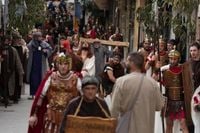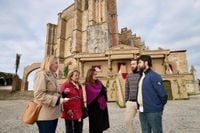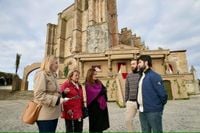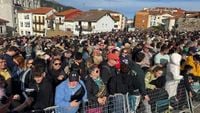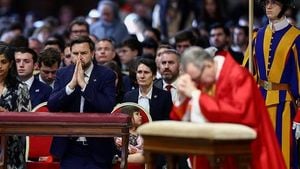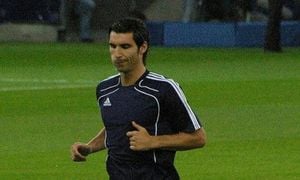On April 18, 2025, the picturesque town of Castro Urdiales, located in the heart of Cantabria, transformed into a vibrant reenactment of Jerusalem from the year 33 AD, as it celebrated the annual Pasión Viviente. This event, recognized as a Festival of National Tourist Interest, has become a hallmark of Holy Week in Spain, drawing thousands of spectators eager to witness the dramatic portrayal of the Passion of Christ.
The Pasión Viviente, which has a rich history spanning over four decades, features nearly 800 local residents who take on various roles in this poignant representation. This year, the event was particularly special as Alejandro Calvo Chargategui returned to portray Jesus Christ after an eight-year hiatus. His return was met with enthusiasm, as he is not only a talented actor but also carries a family legacy, with his father having played the same role back in 1994.
As early as 10:00 a.m., the town's esplanade of Santa María was bustling with activity. The performance commenced with the Last Supper, followed by the Prayer in the Garden, the Kiss of Judas, and the Arrest. The atmosphere was electric, with both locals and tourists gathering to witness this remarkable display of faith and community.
One of the most anticipated segments of the day was the Vía Crucis, a powerful sequence that depicted the trials faced by Jesus as he journeyed towards his crucifixion. This included the dramatic representations of the first, second, and third falls of Christ, as well as poignant encounters with figures such as Mary Magdalene, Mary, and Simon of Cyrene.
As the day progressed, the intensity of the performance grew, culminating in the Crucifixion, Death, Descent, and finally, the Resurrection, which took place at the Atalaya. This concluding segment is not only a testament to the artistic dedication of the cast but also a significant moment that resonates deeply with the audience, reminding them of the themes of sacrifice and redemption.
The Councilor for Social Inclusion, Youth, Families, and Equality, Begoña Gómez del Río, attended the event to express the support of the Government of Cantabria. She emphasized the cultural importance of the Pasión Viviente, stating, "This celebration is an example of how a community can generate culture, cohesion, and tourism from its popular roots." Her remarks highlight the event's dual role as both a religious observance and a significant driver of local tourism.
In addition to its spiritual significance, the Pasión Viviente has a substantial economic impact on the region. Local businesses, including shops, hotels, and restaurants, benefit greatly from the influx of visitors during this time. One local hotelier remarked, "It's the best weekend of the year," underscoring the event's importance beyond the religious sphere.
The staging of the Pasión Viviente is a collaborative effort that involves extensive rehearsals and preparations. The performers, many of whom are not professional actors, dedicate countless hours to ensure that each scene is executed with authenticity and emotional depth. This year, the rehearsals took place at the local association's premises on Calle La Rúa, where the cast prepared to bring their characters to life.
Among the cast members, notable roles included María del Carmen Chagartegui as Mary, and other local actors portraying key figures such as Pilate, Judas, and Peter. Their performances, filled with passion and commitment, contribute to the overall impact of the reenactment, making it a memorable experience for all who attend.
The roots of the Pasión Viviente trace back to 1984 when a group of young people, inspired by their summer camp experiences, collaborated with a local priest, Father Sandalio, to create this unique representation. The first performance took place in 1985, and since then, it has grown into a cherished tradition that continues to evolve while remaining true to its origins.
As the sun shone down on the esplanade, the crowd was captivated by the solemnity and beauty of the reenactment. The blend of faith, art, and community spirit was palpable, reminding everyone present of the shared values that bind them together. The Pasión Viviente is not merely a performance; it is a living testament to the culture and heritage of Castro Urdiales, a celebration that encapsulates the essence of the community.
Every year, the event attracts more participants and spectators, demonstrating its enduring appeal. The organizers have reported an increase in requests from individuals wishing to join the cast, reflecting the growing interest in this remarkable tradition. The Pasión Viviente stands as a powerful reminder that, even in times of rapid change, the threads of history and faith can weave a rich tapestry of shared experience.
In a world often marked by division, the Pasión Viviente of Castro Urdiales offers a moment of unity and reflection, inviting all to partake in a journey that transcends time and space. As the final scenes played out, the audience was left with a renewed sense of hope and a deeper understanding of the significance of the Passion of Christ, echoing the sentiment that this event is indeed the "ceremony of the soul of a people."
